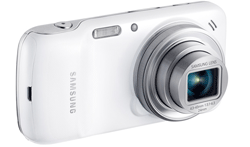Samsung beefs up smartphone camera…New sensor has huge dynamic range…Harvey, Marshall dropped from Origin…Kodak to stop making film base…80 million in 80 years…
Samsung beefs up latest smartphone camera
Samsung’s Galaxy S4 Zoom is yet another smartphone with advanced picture-taking features, including a high-resolution image sensor and optical zoom.

A 16-megapixel sensor is combined with 10x optical zoom, Xenon flash, image stabilisation and a 1.9-megapixel front facing camera.
A ‘Zoom Ring’ on the outer of the lens allows the user to make full use of the optical zoom, but it also doubles as quick access to the camera while on a call for in-call photo sharing. This makes it simple to MMS an image to whomever you’re on a call with.
New sensor has huge dynamic range
Fujifilm and Panasonic have announced new sensor technology with a massively expanded dynamic range.

The organic CMOS image sensor technology uses an organic photoelectric conversion layer with a photoelectric conversion property at the light receiving section of an image sensor, which they claim can achieve performance beyond that of conventional image sensors.
The collaboration combines Fujifilm’s organic photoelectric conversion layer technology with Panasonic’s semiconductor device technology. The resulting organic CMOS image sensor claims to offer the industry’s highest dynamic range of 88dB (14.6 stops of dynamic range in each direction or 29.2 stops EV), along with a 20 percetn improvemetn in sensor sensitivity and broader range of incident light angles to enable the production of more sensitive and compact cameras with better image quality.
By comparison, the best current sensor technology delivers around half that range – approximately 7.7 stops in each direction or 15.3 stops EV.
The two companies will promote the application of the new technology for security cameras, in-vehicle cameras, mobile devices – and digital cameras.
A press release with an overview of the new sensor technology is available at http://www.fujifilm.com/news/n130611.html.
Harvey, Marshall dropped from Origin
One noticeable absence during last week’s NRL State of Origin match was Harvey Norman/Fujifilm sponsorship signage.
Harvey Norman sponsored the annual three-match series for 15 years until 2012. Given the prominent Fujifilm component to the sponsorship signage (and occasional glimpses of Fujifilm boss Dave Marshall at matches), at least some, if not all, of the reported $2 million per year the sponsorship cost was bankrolled by the supplier.
Reports indicate that the NRL was seeking up to $1 million per game for naming rights this year.
Holden quickly snapped up the Origin sponsorship as well as naming rights for the Kangaroos for a reported $5 million when Harvey Norman declined to renew at the end of last year.
Kodak to stop making film base
Another nail in the coffin of film comes with Kodak’s announcement that it will discontinue production of the acetate base upon which film emulsion is laid down.
Cellulose acetate is the plastic base which undergoes treatment to eventually become light sensitive.
The financially-troubled company will be halting operations at the plant in Rochester, NY, responsible for the production of the acetate base after 100 years of production, leaving about 60 workers jobless.
Kodak says it will acquire acetate base from unnamed ‘other manufacturers’ when it exhausts its own supplies.
Or maybe forget about the whole thing?
80 million in 80 years (or something like that)
Nikon Australia has announced that total production of Nikkor lenses reached 80 million in mid-June 2013.
In 1959, Nikon released the Nikon F as well as its first Nikkor lens for Nikon SLR cameras, the Nikkor-S Auto 5cm f/2.
In the same announcement, Nikon notes that the Nikkor brand is 80 years old, which would mean we are currently in the year 2039, given the first Nikkor lens was made in 1959.





Keith, I haven’t seen the media release, but the first Nikkor lens was indeed marketed in 1933 and was available in a number of focal lengths by 1935. (Some sources suggest Nikon actually started lens production in 1932, but they were not marketed until the following year.) The 1959 date is the first SLR Nikkor, for the Nikon F. Nikkor was derived from the Japanese word Nikko and extended with the letter R. Nikon was also the first lens source for ‘Hansa Kwanon’, later to become known as Canon, in 1937.
Thanks John – I did intend to make that change but overlooked it. Thanks for the extra the input. I’ve misapprehended the PR person’s press release pitch. They should ask you to write these things for them! Keith